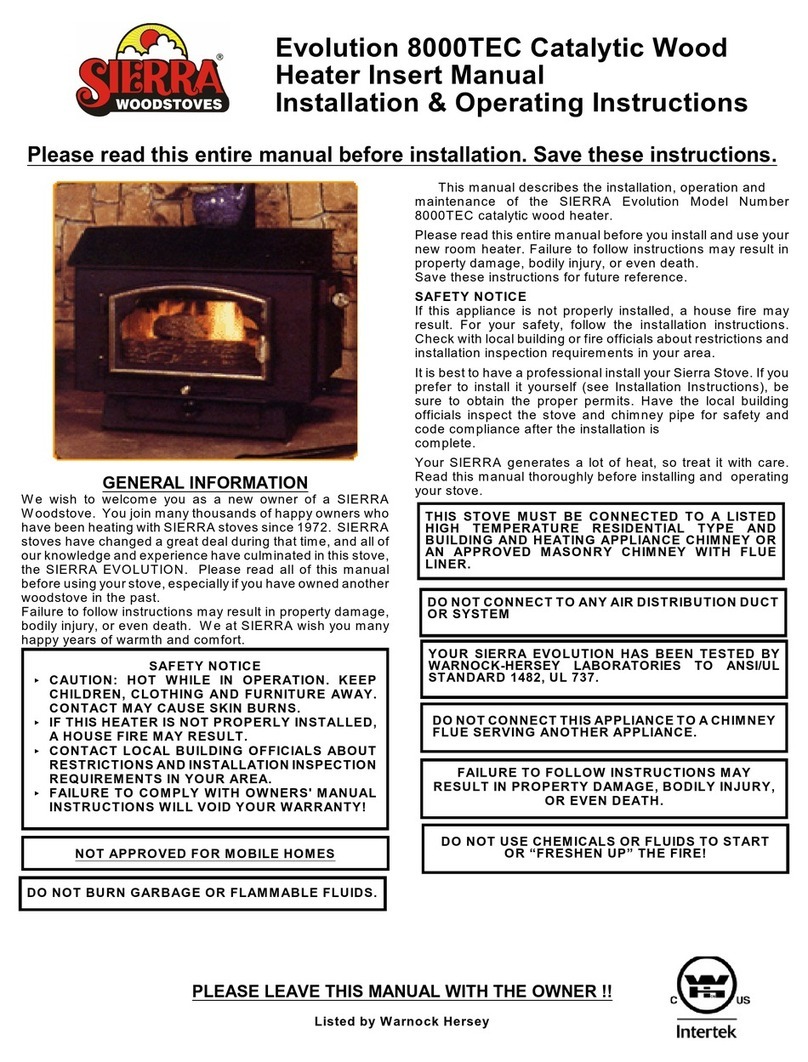
7
material and ashes from the heater and start a new
fire. The fire should be allowed to go out.
DO NOT attempt to remove hot live coals.
Each installation will vary slightly. Therefore, only
with experience can the best firing procedure be
determined.
Opening the Fill Door
Making sure smoke outlet damper is FULL OPEN,
open the door ½ inch for 15 seconds before
opening it completely. This provides a slow
combustion of the accumulated gases above the
fire rather that a sudden burst of flame caused by
the introductions of oxygen. This will also allow
smoke to move out of the heater more completely.
D. Ash Control and Removal
For best results, shake down ashes until live coals
start to fall. Remove the ashes when the fir is low
prior to adding fuel. This should be done daily or
as often as required to avoid ash buildup.
DO NOT allow ashes to build up to the grate level
as this will cause intense heat on the grate and
cause it to warp and have a short life. Inspect the
area around the ash pan and clean out as required.
For disposal of ashes, places ashes in metal
container with a tight fitting lid. The closed
container of ashes should be placed on an
incombustible floor or on the ground, well away
from all combustible materials, pending final
disposal. If ashes are disposed of by burial in the
soil or otherwise locally dispersed, they should be
retained in the closed container until all cinders
have thoroughly cooled.
DO NOT USE A PAPER BAG OR BOX.
E. Creosote & Soot Formation and Removal
When coal is burned, products of combustion
combine with moisture to form a soot residue
which accumulates on the flue lining. When
ignited, this soot makes an extremely hot fire.
When wood is burned slowly, it produces tar and
other organic vapors which combine with expelled
moisture to form creosote. The creosote vapors
condense in the relatively cool chimney flue of a
slow burning fire. As a result, creosote residue
accumulates on the flue lining, the connector pipe
and within the heater. When ignited, this creosote
makes an extremely hot fire.
If this happens, the fire department should be
called immediately. Extinguish the fire in the heater
by dumping a large quantity of coarse salt on the
fire, or by using a dry powder to keep air from
entering the chimney. If possible, do not use water
to extinguish a chimney fire because it could
damage the flue liner. If there is a major creosote
problem, have the chimney, stove pipe and heater
cleaned and inspected before firing the heater
again.
In addition to being a fire hazard, the presence of
creosote will affect the performance by reducing
the draft. This may cause smoking from the fill
door or cause the inability to hold a fire.
The chimney connector and chimney should be
inspected at least once every two months during
the heating season to determine if a soot buildup
has occurred.
To reduce Creosote Problem:
1. Use dry wood.
2. Burn a hot fire for approximately 30 minutes
daily.
3. Keep stack temperature above 250 degrees
Fahrenheit. Below 250 degrees Fahrenheit
produces black liquid creosote.
4. Rather than burn the heater extensively at a
low setting during the mild temperatures of 50
degrees and above, build a small hot fire for a
short period of time.
5. Install the heater with the connector pipes as
short as possible.
Chimney inspection and cleaning
The chimney and heater should be inspected for
creosote buildup every two weeks during the
heating season. Creosote is recognizable as a
black oily or flaky deposit on the walls of the
heater and flue. If creosote has accumulated, it
should be removed to reduce the risk of a chimney
fire.
PERFORMANCE TIPS
A. If your heater SMOKES, has LOW HEAT
OUTPUT, or CANNOT MAINTAIN A FIRE, review
the following:
1. The chimney draft must be at least .04" W.C.
with .06" W.C. the recommended draft.
2. Clean creosote deposits from the chimney and
connector pipe.
3. The connector pipe from the heater to the
chimney may be too long. Reposition the
heater, if possible, for minimum clearances.
4. Do not have more than two 90 degree elbows
in the connector pipe.
5. Horizontal connector pipe must have 1/4" rise
per linear foot.
6. Use a chimney cap to reduce down drafts in
the chimney.
7. More than one heating appliance connected to
the same chimney flue can affect the draft.
8. Ash clean out at the chimney base must be
sealed with the door closed tightly.
9. Remove tree limbs that are too close to
chimney.
10. The chimney height may not be adequate for
proper draft. Increase height if necessary.
11. Burn small hot fires instead of heavily loaded
smoldering fires in mild weather.
12. Sufficient combustion air may not be available
to the heater. This can occur in some newly
constructed highly insulated “light” houses.
Open a window I the room in which the heater
is located., If this helps, then outside air must
be piped to the damper area of the heater.
Consult your dealer for assistance.
B. Fire Burns Too Hot or Too Fast
1. Check door gasket for proper seal.
2. Be sure knob is set to LOW setting.
3. Check combustion air damper. Be sure it is not
sticking open. (See section B under Operating
instructions)
4. For wood burning, allow ashes to build up on
grate.
5. Check chimney draft - .07" W.C. maximum.
6. High winds or prevailing winds may cause
excessive draft.
7. Install a barometric damper in pipe to reduce
drat.
8. Contact dealer for assistance.
C. Coal Fire Goes Out
1. Check chimney draft. Should be no less than
.04" W.C. but .06" is recommended.
2. Shake down ashes more frequently.





























